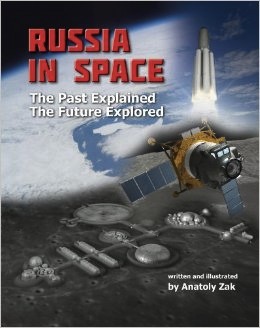Review: Russia in Spaceby Jeff Foust
|
| The big picture that one gets from reading Zak’s book is a program with many concepts for spacecraft and launch vehicles competing with one another for money, and a national space program struggling to fund those efforts, leaving behind a trail of cancelled and delayed efforts. |
Zak focuses primarily on post-Soviet space efforts, although there are some historical examinations of Soviet-era lunar and Mars exploration proposals. The book emphasizes human spaceflight programs in particular, including Russia’s participation on the International Space Station (ISS), proposals to develop replacements for the venerable Soyuz spacecraft and launch vehicle, and various concepts for human missions to the Moon and Mars. There is little discussion of satellites or launch systems not related to human spaceflight: the ambitious, but long-delayed, Angara launch vehicle gets only passing mentions in the book since it is primarily planned for government and commercial satellite launches.
What Zak does cover in the book, though, he chronicles in great detail. In the chapter on the ISS, he thoroughly documents the changing configuration of the Russian segment of the station as Russian plans evolve for what modules they will build and fly. As Zak notes, while NASA regularly states that assembly of the ISS is complete, that is a misnomer: Russia is completing a Multipurpose Laboratory Module now slated for launch next year, and has plans for additional modules by the end of the decade. He also examines the ever-changing plans for new crewed spacecraft, from the plans last decade for Kliper, a lifting body vehicle, to the more conventional capsule shape being pursued now with the PTK-NP project, as well as the various proposals for launching that spacecraft, from the now-cancelled Rus-M to upgraded variants of the Soyuz. These details include numerous illustrations, including some by Zak himself, printed in full color. (Those color illustrations, printed on thick glossy paper, no doubt explain the book’s $50 price tag.)
Even for an expert like Zak, getting all of this information has been a challenge: he notes in the book’s introduction that not only did the press office of the Russian space agency refuse to provide assistance while doing research for the book, the head of that office accused Zak of working for the CIA! That makes Russia in Space a particularly valuable work: few others have both the knowledge and wherewithal to track down this information, particularly when official channels are closed. The big picture that one gets from reading Zak’s book is a program with many concepts for spacecraft and launch vehicles competing with one another for money, and a national space program struggling to fund those efforts, leaving behind a trail of cancelled and delayed efforts. In that respect, it makes the Russian program not so different from its American counterpart.
